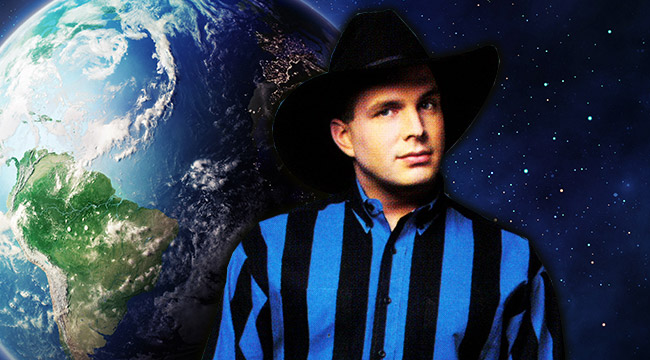
The best-selling solo artist in U.S. history is a very difficult bit of trivia.
The obvious answers are all there and all wrong. Whitney Houston? Nope. Beyoncé? Nah. Kings Elvis Presley and Michael Jackson? Wrong times two. To recall who has sold more albums in America than anyone else, you have to take into account its big old empty middle. And then you have to reckon that the leader is so hard to name because his birth name is Troyal.
Troyal “Garth” Brooks has sold 136 million albums domestically, packed countless stadiums and broke the single-week sales record with a live album. But it didn’t just happen overnight. We didn’t all just decide to give Garth a level of fame that was so intense he could be recognized by a single lowercase letter. This country superstar’s massive crossover success came after a steady climb throughout the early ’90s. And that climb started 25 years ago today with Ropin’ The Wind.
Brooks had had big hits before, to be sure. In fact, signature songs “The Thunder Rolls” and “Friends In Low Places” came from his previous outing No Fences. But Wind crossed over to listeners outside the country bubble like nothing he’d released previously, becoming the first country album to debut at the top of the Billboard 200 in its history. And that was no fluke.
Where Garth’s self-titled debut and Fences toed the company line and lit chaw-scented candles at the altar of George Strait, Wind was the first album where the tag of “country pop” seemed like it was written backwards. Take, for example, “Rodeo.”
The fiddles and Chris LeDoux tapes have been completely excised, replaced with an electric guitar and a keyboard that wouldn’t sound out of place in Stevie Wonder‘s run of ’70s studio wizardry. Brooks makes up for the lack of country instrumentation with his lyrics, filling in the down-home Scantron bubbles with “broncs and the blood” and “steers in the mud,” but there’s no denying that this track is filled with more pop leanings and outright slickness than even the most forward-thinking Music Row Countrypolitan could have cooked up.
To say that Brooks was sneaking pop music craftsmanship to the Cracker Barrel crowd doesn’t give him enough credit. Garth knew exactly what he was doing and what he wanted to be. Though an “Aw shucks” modesty is practically required of big-name country stars, a run through Ropin’ reveals Brooks’ world-conquering aspirations.
“The River” — the track that closes the album — is a winding bit of New Age-y, piano balladry. It turns the idea of chasing your dreams into a vision quest of navigating a tumultuous waterway and ends in a chanted mantra. It’s incredibly on-the-pulse for a nation that would make hits out of an album of Gregorian chanting and a Billy Joel song literally called “River Of Dreams” just a few years later.
And surprisingly, that’s not the only Billy Joel connection this album has — this record contains one cover song. Where previous country pop stars would take the chance to cover a honky-tonk legend and prove they’re still connected to the culture, Brooks rejiggered a song from the Piano Man himself. “Shameless” telegraphed Brooks’ desire for superstardom more than anything he’s done before or since. It did the seemingly impossible and made a Billy Joel song bigger, adding in a full choir and giving the listener a sense that a fleet of jets are about to fly overhead at any minute. It’s clear that Brooks wanted to play to the same sort of stadiums that Joel does. 1991 Garth would have taken an MSG residency in a heartbeat.
There are still plenty of country purists out there who will give you side-eye for admitting a love of Garth Brooks, who see in his massive pop radio overtures on Ropin’ the seeds of bro-country and country radio’s current funk. Those people are wrong. Brooks’ gestures toward the mainstream were the cornerstone of one of the most wildly successful and artistically ambitious periods in country music’s history, especially outside of its typical Southern stronghold. Brooks’ work on Ropin’ led directly to the live broadcast specials, the massive shows in Central Park and the countless broken sales records.
Hank wouldn’t have done it this way, but Hank never somersaulted over 60,000 people from a trapeze over Texas Stadium, so maybe we should stop worrying about what some ghost wants.
Garth hadn’t yet left the rest of canon behind and burned the traditionalist rulebook on Ropin’ The Wind — songs like “Against The Grain” and “We Bury The Hatchet” are still straight-up twanging stompers — but this 11-song collection is definitely the sound of him lighting the match. Twenty-five years later that fire is still burning.






